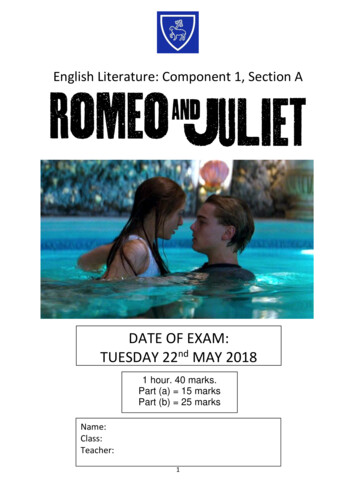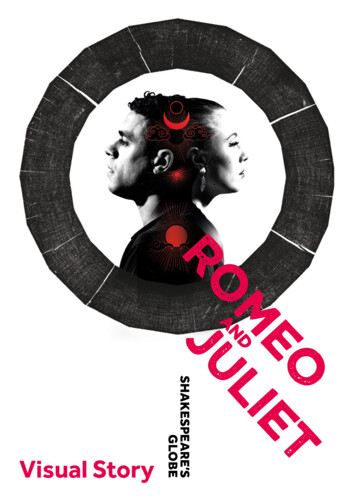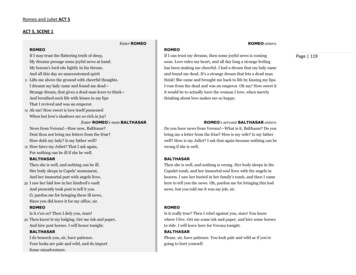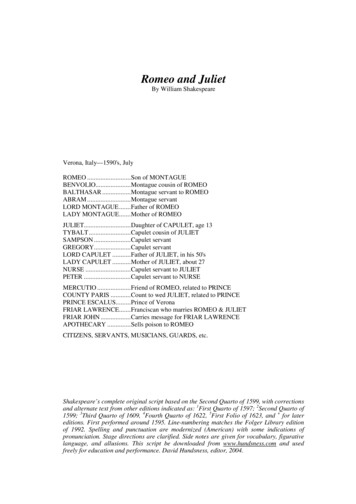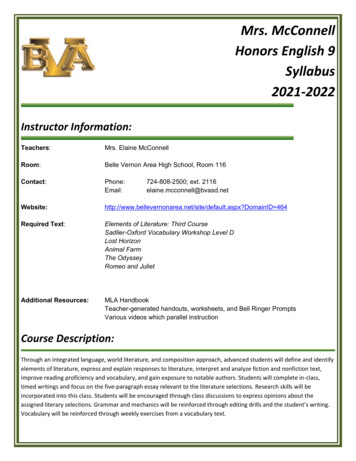
Transcription
Romeo and Juliet Unit PlanStacey MorganEducation 352Professor SchillingDecember 12, 2008
CONTENTS PAGEA. Textbook Information/course informationB. Philosophy of Reading in my content areaC. Readability TestD. Trade BooksE. Lesson plan to activate prior knowledgeF. Lesson plan to introduce new vocabularyG. Lesson Plan modified for ADDH. Lesson plan modified for Learning DisabilitiesI. Lesson plan modified for Gifted and TalentedJ. Lesson plan modified for Behavior DisordersK. Lesson plan modified for AutismL. Lesson plan modified for Mental RetardationM. Lesson plan modified for Sensory ImpairmentN. Unit test and modified testO. Reflection Paper
A. TEXTBOOK/COURSE INFORMATIONNAME OF COURSE/GRADE LEVEL: English 9-1 and English 9-1 RepeatDESCRIPTION OF COURSE: This course is designed for ninth grade students. Itscurriculum includes literature, vocabulary, writing, and public speaking. The literaturecomponent spans from classical stories to the modern novel.NAME OF THE UNIT: Romeo and Juliet by William ShakespeareDESCRIPTION OF THE UNIT: This unit uses William Shakespeare’s Romeo andJuliet to help students analyze family relationships and fate in the character’s lives aswell as their own. We will be closely examining the role of fate vs. deliberate action anddecisions that the characters’ make. By the end of the unit, students should have a senseof the power they have over their own lives and the lives of others by the decisions theymake and the actions they take. Students will use independent and group work,vocabulary charts, graphic organizers, reading skills, and writing skills to analyze anddelve into the world of Shakespeare.TITLE OF TEXTBOOK: Holt Elements of Literature, Third CourseNAMES OF EDITORS: Dr. Kylene Beers and Dr. Lee OdellNAME OF PUBLISHING COMPANY: Holt, Rinehart, and WinstonCOPYRIGHT DATE: 2008READING LEVEL OF TEXTBOOK: Ninth grade reading level
B. PHILOSOHY OF READING IN THE CONTENTSTANDARDS:9.1.1 Identify and use the literal and figurative meanings of words and understand theorigins of words.9.3.2 Compare and Contrast the presentation of a similar theme or topic across genres toexplain how the selection of genre shapes the theme or topic.9.3.3 Analyze interactions between characters in a literary text and explain the way thoseinteractions affect the plot.9.3.4 Determine the characters’ traits by what the characters say about themselves innarration, dialogue, and soliloquy.9.3.5 Compare works that express a universal theme and provide evidence to support theviews expressed in each work.9.3.10 Identify and describe the function of dialogue, soliloquies, asides, character foils,and stage designs in dramatic literature. Dialogue: a conversation between two characters Soliloquies: long speeches in which characters, on stage alone,reveal inner thoughts aloud Asides: words spoken by characters directly to the audience Character foils: characters who are used as contrast to anothercharacter Stage designs: directions and drawings for the setting of a play 9.3.12 Analyze the way in which a work of literature is related to the themes and issuesof its historical period.9.4.1 Discuss ideas for writing with classmates, teachers, and other writers and developdrafts alone and collaboratively.9.4.3 Use precise language, action verbs, sensory details, and appropriate modifiers9.5.8 Write for different purposes and audiences, adjusting tone, style, and voice asappropriate.9.6.3 Produce legible work that shows accurate spelling and correct use of conventions ofpunctuation and capitalization.
9.7.1 Summarize a speaker’s purpose and point of view and ask questions concerning thespeaker’s content, delivery, and attitude toward the subject.9.7.2 Choose appropriate techniques for developing the introduction and conclusion in aspeech, including the use of literary quotations, anecdotes, and references to authoritativesources.9.7.5 Produce concise notes for extemporaneous speeches (speeches delivered withouta planned script).9.7.10 Assess how language and delivery affect the mood and tone of the oralcommunication and make an impact on the audience.
IMPORTANCE:This unit of study is important to ninth grade students because reading and analyzingRomeo and Juliet will help students develop analytic reading skills. This is a skill thatthey will need in order to be responsible and informed members of society as well asexcel in higher education or the job field. Through this play, students will be able toanalyze themes that relate to them such as fate, young love, conflict between and withinfamilies, the effects of violence, and suicide. This will give students a voice and anavenue to explore difficult subjects that many have experienced and/or are currentlyexperiencing. Because the unit focuses on whether fate or personal decisions have themost impact over the characters’ lives, by the end, students should realize that they havethe power to improve or destroy their lives and the lives of others. They will also learnmore about the historical period in which Shakespeare was writing. Lastly, I believe thatShakespeare’s plays have intrinsic value in and of themselves, and Romeo and Juliet is agreat piece of authentic literature to experience.PHILOSOPHY:My philosophy of reading in English and Language Arts is that it is necessary and hasinfinite benefits because it can offer prime examples of the English language at its best,cross borders and ethnic boundaries, and cultivate and develop higher level thinkingskills. Literature is the foundation of my content because it is what keeps our languageand culture alive. Reading is the key to unlocking vast storehouses of knowledgecontained within literature. For example, within the Romeo and Juliet Unit, students willstudy history and Elizabethan culture; examples of the English language at its finest inShakespeare’s words, puns, and constructions; and themes such as love and violence thatare still relevant to them today.I learned more about racial, cultural, and religious tensions in my English classes in highschool by reading books such as John Howard Griffin’s Black Like Me, JamesMcBride’s The Color of Water, Chinua Achebe’s Things Fall Apart, and Elie Wiesel’sNight than I did in my history classes. Reading is essential to my content area because itallows students to learn more about themselves and others while they learn about theEnglish language. I believe this is the point of studying English and Language Arts: tolearn through the words and stories of others. Reading makes students analyze theirbeliefs and the world around them by introducing various points of view. This teachesempathy, broadens minds, and improves cognitive and reflective abilities. Reading alsohelps improve students’ communication skills because it exposes students to artful andeffective written communication styles and vocabularies and helps students develop aknowledge base from which to draw conclusions and opinions.
READABILITY TESTText: Holt Elements of Literature, Third Course, Romeo and Juliet by WilliamShakespeareExcerpt 1Two households, both alike in dignity,In fair Verona where we lay our scene,From ancient grudge break to new mutiny,Where civil blood makes civil hands unclean.From forth the fatal loins of these two foesA pair of star-crossed lovers take their life;Whose misadventured piteous overthrowsDo with their death bury their parents’ strife.The fearful passage of their death-marked love,And the continuance of their parents’ rage,Which, but their children’s end, naught could remove,Is now the two hours’ traffic of our stage;The which if you with patient ears attend,What here (901)Sentence length: 2.8 sentencesNumber of syllables: 132 syllablesExcerpt 2What say you? Can you love the gentleman?This night you shall behold him at our feast;Read o’er the volume of young Paris’ face,And find delight writ there with beauty’s pen;Examine every married lineament,And see how one another lends content;And what obscured in this fair volume liesFind written in the margent of his eyes.This precious book of love, this unbound lover,To beautify him only lacks a cover.The fish lives in the sea, and ‘tis much prideFor fair without the fair within to hide.That book in many’s eyes doth share (916)Sentence Length: 5.1 sentencesNumber of Syllables: 130 Syllables
Excerpt 3But soft! What light through yonder window breaks?It is the East, and Juliet is the sun!Arise, fair sun, and kill the envious moon,Who is already sick and pale with griefThat thou her maid art far more fair than she.Be not her maid, since she is envious.Her vestal livery is but sick and green,And none but fools do wear it. Cast it off.It is my lady! O, it is my love!O, that she knew she were!She speaks, yet she says nothing. What of that?Her eye discourses; I will answer it. (934)Sentence Length: 13 sentencesNumber of Syllables: 119 SyllablesExcerpt 4God’s bread! It makes me mad.Day, night; hour, tide, time; work, play;Alone, in company; still my care hath beenTo have her matched; and having now providedA gentleman of noble parentage,Of fair demesnes, youthful, and nobly trained,Stuffed, as they say, with honorable parts,Proportioned as one’s thought would wish a man—And then to have a wretched puling fool,A whining mammet, in her fortune’s tender,To answer, “I’ll not wed, I cannot love;I am too young, I pray you pardon me”!But, and you will not wed, I’ll pardon you!Graze where you (986)Sentence Length: 3.4 SentencesNumber of Syllables: 128 Syllables
Excerpt 5I will be brief, for my short date of breathIs not so long as is a tedious tale.Romeo, there dead, was husband to that Juliet;And she, there dead, that Romeo’s faithful wife.I married them; and their stolen marriage dayWas Tybalt’s doomsday, whose untimely deathBanished the new-made bridegroom from this city;For whom, and not for Tybalt, Juliet pined.You, to remove that siege of grief from her,Betrothed and would have married her perforceTo County Paris. Then comes she to meAnd with wild looks bid me devise some meanTo rid (1021)Sentence Length: 4.5 SentencesNumber of Syllables: 129 SyllablesI think that the readability test is a good place to start when trying to determine theappropriate reading level of a particular classroom material, but I do not think it isinfallible. According to the test, Romeo and Juliet is written at a level appropriate forsixth graders; however, I believe the test results are skewed by Shakespeare’s sentencevariety. One sample passage had 13 sentences in it while another only had 2.8 sentences.The directions said to use more samples to compensate for sentence variability, so Iincluded five samples instead of three. The results were still consistent with a sixth gradereading level. This surprised me as the play is often taught at a ninth grade and evencollege level. One limitation of the test is that it does not consider content andvocabulary. I believe the content of the play is more suited to high school and collegestudents than it is for sixth graders.
D. ANNOTATED LIST OF TRADE BOOKS FOR ENGLISH/LANGUAGE ARTSDraper, S. (2001). Romiette and Julio. New York: Simon Pulse.Romiette and Julio is a young adult novel about two teenagers who fall into a forbiddenromance. Their love is opposed by a dangerous local gang because Romiette is AfricanAmerican and Julio is Hispanic bringing racial themes and tension to the forefront of thenovel. The pair devise a plan to stay together and avoid the fate of Shakespeare’s starcrossed lovers whose names resemble their own. It is a modern twist of Shakespeare’sfamous play that many students may more readily relate to because of the present-daysituation and language.Leong, S. (Ills). (2007). Romeo and Juliet: Manga Shakespeare. New York: AmuletBooks.Manga is a form of Japanese comics that is currently very popular among teenagers. Thismanga novel adapts Shakespeare’s play into pictures and still utilizes the original words.It places the characters in present-day Tokyo where Romeo is a rock idol, and Juliet is afashionable Shibuya girl. The pictures make the text more interactive and modernize thetale for a modern audience.Rinaldi, A. (2001). The Coffin Quilt. San Diego: Gulliver Books.Based on the infamous Hatfield and McCoy feud, The Coffin Quilt is a young adult novelthat looks at the tragic effects of hatred on two families through the eyes of FannyMcCoy, a sixteen year old girl. The violence escalates as the narrator’s sister, RoseannaMcCoy, runs off with a Hatfield boy. Fanny realizes that her sister has a morbidfascination with violence and causes most of the continued problems between thefamilies. The novel receives its title from a quilt that Roseanna decorates with coffins torecord the fate of the two families. Throughout the novel, Fanny acts as a voice of reasonas she tries to break the cycle of violence.Shakespeare, W. (2001). Hamlet. New York: Washington Square Press.Hamlet is another one of Shakespeare’s great tragedies. It will be a good play tointroduce to any student who is interested in reading more of Shakespeare’s plays.Hamlet is the young prince of Denmark who sees his father’s ghost and learns that hisUncle Claudius poisoned his father to steal the crown and King Hamlet’s wife. PrinceHamlet is plagued by mental illness as he copes with his mother’s marriage to his uncleand his desire for revenge.Shulman, I. (1990). West Side Story. New York: Pocket Books.This novel was based on the musical by the same name which was originally based onRomeo and Juliet. It offers a contemporary spin on Shakespeare’s play as the two maincharacters, Tony and Maria, fall in love. Their relationship is dangerous as the two are
associated with rival gangs—the Sharks and the Jets. The novel adds cultural in additionto familial tension to the mix as the Sharks are Puerto Rican and the Jets are American.Like the original play, there are deaths, mix-ups, tragedy, and finally peace between thefeuding parties.Trade books can enhance my classroom’s content because they can offer enrichment forthose students who are interested in pursuing an author or topic more in-depth. They willhelp ensure that learning can continue outside of the classroom. Trade books can also beused within the classroom to break up the routine and give students a break from theirtextbook; it is important to diversify students’ learning material. Trade books can also beused to draw students into a topic by capitalizing on their interests. For example,students who like history may appreciate The Coffin Quilt for its Civil War and historicalcharacters. It still has traces of Romeo and Juliet within it, so they will be covering someof the same themes in a different work of literature. Hispanic or African-Americanstudents may appreciate and relate to West Side Story or Romiette and Julio on a deeperlevel than Romeo and Juliet even though they explore the same topics and share the samegeneral plot.
E. LESSON PLAN TO ACTIVATE PRIOR KNOWLEDGEManchester CollegeEducation Department/Lesson Plan FormatLesson By: Stacey MorganLesson: An Interview with ShakespeareAge or Grade Intended: English 9Approx. length: 40 minutesAcademic (IN State) Standards: 9.7.1 Summarize a speaker’s purpose and point ofview and ask questions concerning the speaker’s content, delivery, and attitudetoward the subject.Performance Objectives: While listening to an interview with Shakespeare, studentswill complete a study guide based on facts and inferences from Shakespeare’s answerswith 12 out of 12 correct answers.After the interview, students will formulate and write down a question on their studyguide about the life or time of Shakespeare with 100% participation.Assessment: After the interview, students will have the opportunity to work with apartner to compare answers and fill in any of the answers that they missed. We will thengo over the answers as a class to ensure that their study guides are complete and correct.I will then collect the papers to review their answers and formulated questions.Advanced Preparation by Teacher: Mr. Conlon has already agreed to help me by doinghis Shakespeare routine for the class. I will need to research and write the dialoguebetween Mr. Conlon (A.K.A Shakespeare) and me. We will need to rehearse theinterview. I will also need to create and make copies of the study guide for the studentsto complete.Procedure:Introduction: Welcome to class. We are just beginning our Shakespeare unitwhere we will be studying fate and family using Romeo and Juliet. To help get us started,we have a special guest here today. Please welcome Mr. William Shakespeare, who hasbeen so gracious as to rise from grave to meet with us today. He has agreed to beinterviewed to give us a little background information on Romeo and Juliet as well assome background information about himself.Step-by-step:1. Ask students to clear everything off of their desks except for a writing utensil.2. Hand out the study guide. (See attached study guide with Bloom labels andanswers.) Ask them to fill out the study guide as they listen carefully toShakespeare’s answers (M.I. Verbal/Linguistic).3. Ask interview questions to Mr. Conlon who is dressed in costume and hasassumed the character of Shakespeare.
4. Have each student write a question on the bottom of the study guide that sheor he is interested in concerning the life and times of Shakespeare that was notanswered during the interview (M.I. Intrapersonal).5. Break students into pairs. Have them discuss and compare their answers (M.I.Interpersonal). Let them fill in any answers to questions that they missedduring the interview.6. Bring students back together as a class. Review and discuss the answers tothe study guide (M.I. Verbal/Linguistic).7. Collect papers to review questions.Closure: Today we learned a little about the author of the play Romeo and Juliet.He gave us information about his life as an actor and writer as well as information abouthis family. Even though he wrote the play over four centuries ago, many of the issues inthe play are relevant even today. As we read and watch Romeo and Juliet, I want you tokeep Shakespeare’s family, the Montague and Capulet families, and your own family inmind as we try to discover together what makes learning Shakespeare so valuable andrelevant to us today, almost four hundred years later.Adaptations/Enrichment:Students with learning disabilities can be asked just to listen to the presentation and thengiven a copy of the script afterwards to help them fill in the study guide to accommodatefor a slower processing rate.Working in groups to review answers will also be beneficial to students with learningdisabilities because they can learn from their peers and find answers they may havemissed on their own.Students with autism will also benefit from working in groups because it will help themwork on their social skills.Gifted and talented students could work on their own interview and script withShakespeare, Shakespeare’s wife, Queen Elizabeth, or one of the main characters fromthe play to present to the class.Self Reflection:Did the students find the interview interesting or did their attention begin to wane?Were the students able to stay on task using the study guide?Was the timing okay?What went well?What would I change next time, and would I consider doing this lesson again?
Interview with Shakespeare ScriptTeacher: Welcome to Warsaw High School, Mr. William Shakespeare! Thank you fortaking the time to come all the way to Indiana from England to answer a few of ourquestions.Teacher: People today think of you as a great writer and playwright. Your work is knownaround the world—in fact, your plays have been translated into every language, and youare considered by many to be the greatest writer who has ever lived. Did you ever imaginethat you’d be so famous?Shakespeare: I actually considered myself to be a professional actor—not a writer. I wrote playsin order to act them out and to make money. I wrote plays to be entertainment for the masses, notto be read as great literature. In fact, my plays weren’t meant to be read at all: they were meant tobe performed and watched!Teacher: We are about to read and watch your famous play Romeo and Juliet. Can you tellus what kind of play it is and what your inspiration was to write it?Shakespeare: Romeo and Juliet is a type of play called a tragedy. A tragedy is a play in whichserious events take place that eventually lead to an unhappy ending for the main character.Sometimes the character’s downfall is caused by something he or she did, and sometimes it iscaused by fate or the actions of others. In Romeo and Juliet’s case, they were “star-crossedlovers” from the very start. They weren’t just innocent bystanders of fate however but you willbe able to judge that for yourselves later. My inspiration for this play came from a 1562 poem bya man named Arthur Brooke called The Tragicall Historye of Romeus and Juliet. However, theirstory began before that poem was written. Even Arthur Brooke borrowed it from older Italianstories that were handed down through time.Teacher: One of the themes we will be looking at while studying Romeo and Juliet is“family.” Would you be willing to tell us a little about your family?Shakespeare: Well, I was born in April of 1564, two years after the poem The Tragicall Historyeof Romeus and Juliet was published, and I was baptized on April 26th in my home town of
Stratford-upon-Avon. My dad, John Shakespeare, was a glover and at one point served as thetown bailiff. I occasionally helped him with his gloving business when I was young. My mother,Mary Arden Shakespeare, came from an aristocratic family. I had six living brothers and sisters,so it was generally pretty busy around the house. We were pretty well-to-do until my fatherencountered some money problems when I was twelve. When I was eighteen years old, I marriedAnne Hathaway who was twenty-six and pregnant with our daughter Susanna at the time. Shelater gave birth to our twins Judith and Hamnet as well. My two daughters lived to grow up andstart families of their own, but my only son, Hamnet, died when he only was eleven years old.Teacher: You are a man of a great many words: your thirty-seven plays contain over 10,000different words. What kind of schooling did you have to give you such an extensivevocabulary?Shakespeare: I attended a grammar school where I learned to read and write using religiousmaterial. I also studied stories by Ovid, who became one of my favorite authors, and I studiedplays by a man named Plautus. I didn’t attend school very long, only until my early teens.However, I continued to read and write. If I needed a word and there wasn’t one that quiteexpressed what I wanted to say, I would just create a new one that would!Teacher: Not very much is known about you between the years of 1585 and 1592. This timein your life is often labeled as “the lost years.” Will you finally end all of the secrecy and tellus what you were doing at that time?Shakespeare: I’m afraid that is a secret that I have already taken with me to the grave. However, Idid move to London leaving my wife and kids in Stratford-upon-Avon during this time andeventually began my acting career there.Teacher: What did you do following “the lost years?”Shakespeare: The London theatres were closed in 1593 because of the Bubonic Plague, so Iwrote and published some poetry. When the theatres reopened a year later, I continued to act andwrite for The Lord Chamberlain’s Men—the most prominent theatre company in England, and, ifI do say so myself, a particular favorite of Queen Elizabeth herself. Even though a woman couldrule the country, women did not act at this time. Female roles were played by young men whose
voices hadn’t yet changed. Our name changed to The King’s Men after King James ascendedEngland’s throne and replaced the Lord Chamberlain as our patron in 1603.Teacher: Would you mind walking us through an average day for you as an actor andplaywright?Shakespeare: Well, about 7:00 A.M a couple of us would meet at the Mermaid Tavern to discusscompany business over breakfast. We’d hire a few boys to post play bills and spread the wordabout tonight’s play. When we arrived at the theatre awhile later, we would rehearse and get thetheatre, props, and costumes ready for the show. By 11:30 a crowd would start to form, and thedoors would open at 1:00 P.M. The crowd was always a mixture of people: prostitutes, pickpockets, vendors, performers, low class, middle class, aristocrats—they all turned up for theshow. We’d often have a full house of over 3,500 people in attendance. The other actors and Iwould take the stage at 2:00, and our performances usually would last about two hours. After thecrowds left, we would rehearse for tomorrow’s performance and tally up our earnings for thenight. Then, we’d head back over to the Mermaid Tavern around 6:30 for dinner. That’s when Iwould unveil a new play script. I’d make some changes here and there until the rest of thecompany liked it and agreed to buy it. I’d head home generally around 9:30 and continue to writefor a few more hours. Then, I’d go to bed just to wake up and do it all over again the next day—that is if the Puritans or the Plague hadn’t shut down the theatres. During those times, I’d workon some sonnets and poems.Teacher: Many people believe you were unfaithful to your wife while you were in Londonbecause some of your sonnets are written about a “Dark Lady.” Who was she?Shakespeare: That’s another secret that I’ve taken to the grave with me, although many believeher name was Aemilia Lanier, a Venetian musician and poet.Teacher: You are often associated with the Globe Theatre. Tell us how the Globe Theatreoriginated.Shakespeare: Ah, yes—the Globe. We originally performed in a theatre named “The Theatre.”It was built by a man named James Burbage. He owned the building, but not the actual groundwhere it was built. That, he leased. When the lease expired in 1599 the landowner kicked us out
and claimed to own the entire property, the theatre included. So, one night when he was out oftown, a few actors, a carpenter, and James Burbage’s sons dismantled The Theatre and carried theplanks away. We used those planks to build the Globe Theatre. Unfortunately, it burned to theground in 1613 during a performance of my play Henry the Eighth. It was rebuilt a year later onlyto be shut down by the Puritans in 1642. I was long gone by then. I moved back to Stratfordupon-Avon sometime between 1610 and 1613 to retire. I permanently retired on April 23, 1616,exactly fifty-two years to the date of my infant baptism. I was buried in Holy Trinity Church.Teacher: There’s been much discussion and concern over what you left your wife Anne inyour will.Shakespeare: I don’t know what all the concern is about. I left her my second-best bed!Teacher: You also had a curse put on your gravesite. Do you mind telling us what it says?Shakespeare: Good friend, for Jesus’ sake forbearTo dig the dust enclosed here!Blessed be the man that spares theses stonesAnd cursed be he that moves my bones.Teacher: With that said, we will let you get back to your resting place in Stratford-uponAvon. Again, thank you so much for taking the time to talk with us!ReferencesAnderson, R. (2008). Elements of literature. Austin, TX: Holt.Best, M. (2005). Shakespeare’s life and times. Retrieved September 19, 2008, fromhttp://ise.uvic.ca/Library/SLT/Conlon, J. (2008). Introduction to Shakespeare and Romeo and Juliet.Mowat, B. A. & Werstin, P. (Eds.) (2005). Discover Shakespeare. Retrieved September 19, 2008,from http://www.folger.edu/template.cfm?cd 8657.
An Interview with Shakespeare Study Guide1. What did Shakespeare consider his main profession to be?2. Explain why Shakespeare might find it unusual for people to study his plays asexamples of great literature.3. What kind of play is Romeo and Juliet?4. How would you describe Shakespeare’s family life? How did it change as he grewolder? Support your conclusion using examples from the interview.5. What event do we know occurred during the “lost years”?6. What is the name of Shakespeare’s theatre company? Why was it called that?7. List three things that Shakespeare might have done during a regular day as anactor/playwright.8. Who was Aemilia Lanier?9. What was the name of the theatre that Shakespeare helped build?10. Why do you think the Puritans, a strict religious group, wanted to close down thetheatre? Why was the bubonic plague such a threat to Shakespeare’s profession?
11. What did Shakespeare leave his wife, Anne, in his will? How do you think shereacted?12. Based on what you know, how would you compare Shakespeare’s relationshipwith theatre to that of his relationship with his wife?If you could interview Shakespeare, what would you ask? Write down at least onequestion that you still have about the life and/or times of Shakespeare.
An Interview with Shakespeare Study Guide Answer Key1. What did Shakespeare consider his main profession to be? (Bloom: Knowledge)He considered himself to be more of an actor than a writer.2. Explain why Shakespeare might find it unusual for people to study his plays asexamples of great literature. (Bloom: Comprehension)His plays were meant to be acted out and watched instead of read.3. What kind of play is Romeo and Juliet? (Bloom: Knowledge)It is a tragedy.4. How would you describe Shakespeare’s family life? How did it change as he grewolder? Support your conclusion using examples from the interview. (Bloom:Analysis) He can from a large, wealthy family. When he was only 18 he marriedAnne Hathaway and had three children. His son Hamnet died when he was only11. Unlike his childhood family, his family with Anne was small. He left them tobecome an actor in London, so he didn’t have much of a family life as he grewolder.5. What event do we know occurred during the “lost years”? (Bloom: Kno
Text: Holt Elements of Literature, Third Course, Romeo and Juliet by William Shakespeare Excerpt 1 Two households, both alike in dignity, In fair Verona where we lay our scene, From ancient grudge break to new mutiny, Where civil blood makes civil hands unclean. From forth the fatal loins of these two foesFile Size: 810KB
